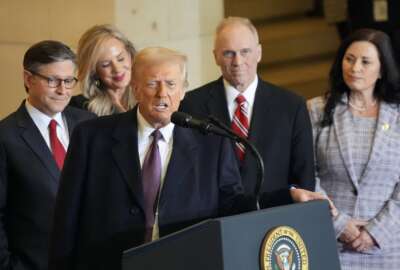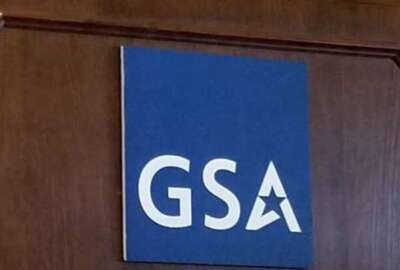You can almost taste the repeal of these social security holdbacks
"The biggest challenge on this has been the cost of repeal," NARFE's staff vice president John Hatton said.
Can it be that the repeal of the windfall elimination provision and the government pension offset will actually happen? The WEP and GPO that hold back Social Security benefits for certain federal and other government employees? The Federal Drive with Tom Temin got the latest from a leading advocate for repeal from the National Active and Retired Federal Employees Association, John Hatton.
Interview transcript:
Tom Temin John, you’ve been watching this and handicapping this. And it marches like a centipede ever closer.
John Hatton Yeah. Well, you know, we’ve got a big step that happened Tuesday morning with the filing of a discharge petition by Garret Graves of Louisiana and also with the support of Abigail Spanberger from Virginia. A discharge petition, if it gets 218 signatures, would force a House floor vote. There’s a little bit delay, seven legislative days. So we have the clock running down on it. So we’re trying to get those 326 co-sponsors in the House to sign on to this bill. We get 218 of them, which I think is a realistic goal given the amount of support for the bill’s co-sponsors, we can get a House floor vote. And so this is the first real serious effort at a discharge petition that we’ve seen. Some people may remember from last Congress, there was a House consensus calendar motion that was pending. And that was a little bit different because the committee of jurisdiction was able to kind of kill that, whereas in the discharge petition, the same thing would not apply. So this is a new scenario for us. And so we’re really excited. So certainly urging every federal retiree that cares about this issue to contact their members of Congress.
Tom Temin And by the way, is this only for SERS employees, the older retirees?
John Hatton Yes, it applies. The CSRS retiree is because when you are covered by CSRS, you weren’t paying into Social Security and you earned a pension for that CSRS and you might have earned a social care benefit through other private sector employment, but because you had that CSRS pension your social security benefits are reduced by the windfall elimination provision, government pension offset will cut back on spousal or survivor benefits. And so it’s for the federal side, it’s just the CSRS, but it also applies to police officers, firefighters, teachers, a lot of state and local government employees, depending on their system. Is it more like CSRS or is it more like FERS? And so it’s not everybody, but it’s a lot of them.
Tom Temin And if you were CSRS or on a CSRS pension and you never worked anywhere else but the federal government, you’re still out of luck.
John Hatton Well then you would have never earned any Social Security benefits and so it doesn’t actually apply to you. So you have to earn basically ten years or 40 quarters to qualify for Social Security. Once you do, though, that amount is cut back because you have that CSRS pension simply just because you worked in that other employment. And then you have to get up to 20 years for it to start to phase out. So for people who just did enough to work to qualify for Social Security, whether they worked part time as a second job while they’re working CSRS, whether they worked before and after supplement their income, they’re penalized because they work for the federal government.
Tom Temin Got it. Okay. It seems like the almost convincing battle is mostly won. It’s now a matter of legislative tactical maneuvering.
John Hatton Yeah. The biggest challenge on this has been the cost of repeal. So we’ve been very successful getting a lot of members of Congress to say, yeah, this is not fair. It certainly it goes too far to sign on to this bill saying know we have to do something about it. What we faced obstacles with at the committee level or the leadership level in Congress is that, you know, this would hurt the solvency of Social Security to some degree. Now, it may be a percentage of that Social Security trust fund, but it’s still a lot of money. From our perspective, that’s a lot of money that’s coming out of the pockets of federal retirees and other retired public servants. But from the actuaries perspective, that’s money that’s not going to be going to other Social Security benefits. So that’s been our challenge. What we’re trying to do is really ramp up and convert people who are co-sponsors to saying we have to have a floor vote on this. You know, that at least provides more leverage in the continued battle to get some type of solution here.
Tom Temin We’re speaking with John Hatton, staff vice president of the National Active and Retired Federal Employees Association, NARFE. And then the federal pay raise seems to be in play. It ain’t much, but there’s something going to happen.
John Hatton Yeah. President Biden issued his alternative pay plan, a 1.7 across the board, and 0.3 percentage points for locality pay. I would expect that to go into effect for 2025. Now, that’s less than what the military pay raise is supposed to be an average of 4.5%. And that’s based on what private sector wages and salaries have done recently. So it’s disappointing to see that reduced pay raise for federal employees. It’s basically due to that deficit or the debt limit deal that they reached last year, which is capping agency spending levels at 1% increase this year. So it’s more of that 1%, but it’s less than the 4.5% that they really should be getting.
Tom Temin Well, do you think that perhaps the White House is. Pushing for the smaller raise because a bigger one would signal the fact that they’re acknowledging that there’s been a lot of inflation.
John Hatton And perhaps I think if there is, that’s the cynical view of inflation as much as it is that they have other fiscal constraints and they’re prioritizing other spending over spending for federal employee pay raises. Now, we all certainly can still make the push for them to do something bigger on locality pay in December. But yeah, I think that’s an uphill battle right now.
Tom Temin Well, and then in the backdrop of all of that is there has to be government funding. Right now the question I guess shut down is not quite the feverish feeling yet, but it’s rather the length of the CR, which has its own calculus.
John Hatton Right. I think at the end of the day, we’re going to have a continuing resolution through December. Now, the House right now is trying to vote on a bill this week to have a CR that goes through March that includes some other controversial provisions. I think question one is whether they can even get the votes to pass that that CR in the House this week. If they do, I still think that’s pretty much dead on arrival in terms of the length of time and the extraneous provisions in the Senate. So the Senate would send back something more like that CR to December and without some of those controversial provisions. And hopefully that gets signed and avoids a shutdown. So whether the House passes something this week or not, I don’t think that that bill is going to be what drives the it get actually gets into law.
Tom Temin And we should mention the fact that last month was the NARFE annual meeting in St. Louis and it was the first one I attended. I have to say I was surprised at the degree of engagement and enthusiasm that retirees, sometimes long retirees, have in these issues. I don’t really have a question here, but your sense that retirees don’t retire from life or fame or from advocacy for the federal person, but really, they added a long time.
John Hatton Yeah. And I think when you’ve worked an entire career in the federal service that sticks with you. I think people have been drawn to that type of work due to, you know, patriotism, due to caring for their country and wanting to do something good for the country. And, you know, I think it’s natural for them to be part of an organization like NARFE or part of other organizations in retirement. So, you know, it’s not like you’re just hanging up the boots entirely in terms of, you know, still being part of that national conversation.
Tom Temin All right. Well, the conversation will continue. John Hatton, the staff vice president of the National Active and Retired Federal Employees Association, NARFE. As always, good to have you.
John Hatton Thank you for having me.
Tom Temin We’ll post this interview at federalnewsnetwork.com/federaldrive. Hear the Federal Drive on demand, subscribe wherever you get your podcasts.
Copyright © 2025 Federal News Network. All rights reserved. This website is not intended for users located within the European Economic Area.
Tom Temin is host of the Federal Drive and has been providing insight on federal technology and management issues for more than 30 years.
Follow @tteminWFED






